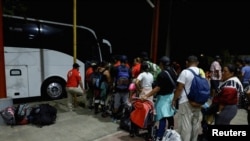U.S. officials processed an estimated 300,000 people at the U.S. border with Mexico in December, which would be the highest number ever recorded, according to multiple news organizations.
While the Department of Homeland Security will release the December numbers later this month, Reuters and other news organizations estimate that 300,000 people attempted to cross the border in the final month of 2023, with about 50,000 of them coming through designated points of entry.
Those estimates suggest that the first three months of fiscal 2024, which began in October, will set a record. Experts said multiple factors are causing migrants — many from as far away as Asia, Africa and the Middle East — to come to the U.S. border, either legally, as asylum-seekers, or illegally.
The record-level border encounters come as the U.S. enters a presidential election year in which the topic of immigration is expected to play a major role.
President Joe Biden, expected to receive the Democratic nomination, has repeatedly said that immigrants are one of the country’s strengths, even as he has taken steps to curb the current influx. Former President Donald Trump, the prohibitive favorite to win the Republican nomination, has long advocated for tighter control on immigration and has frequently used incendiary language to describe immigrants to the U.S.
‘Push’ and ‘pull’ factors
Michelle Mittelstadt, director of communications and public affairs for the Migration Policy Institute, told VOA that multiple factors have contributed to the elevated number of migrants at the southern border.
Mittelstadt said that many migrants arriving at the border have been “pushed” out of their own countries by economic and political upheaval, natural disasters, and other crises. For example, the collapse of the Venezuelan economy over the past decade has driven about 8 million people from that country. While many have found refuge in other South American countries, such as Colombia, hundreds of thousands have made the long and dangerous trek to the U.S.
Other factors contribute to “pull” migrants to the U.S., including the strength of the country’s economy, which currently has two open jobs for every American seeking work. Mittelstadt said that what she called the growing professionalization of human smuggling organizations has also made the gamble of migration seem more appealing, and that the possibility that Trump might be reelected in 2024 has encouraged many migrants to attempt to cross the border before stricter immigration measures can be put in place.
Hovering above all these factors is the glaring evidence that the American system for processing asylum-seekers is deeply broken: Individuals admitted to the country while their claims are assessed frequently wait several years before they receive a hearing in an immigration court. More than 3 million cases are pending, more than 1 million of which were added in the past 12 months.
“It’s hard to see that any of these factors are going to lessen anytime soon, even were there to be very sharp policy changes by the U.S. government,” Mittelstadt said.
Spreading crisis
States along the southern border have long complained about the increased number of migrants crossing into the U.S. On multiple occasions, small border towns have faced sudden influxes of thousands of migrants in the space of a few days.
Leaders of border states, such as Texas Governor Greg Abbott, have complained that the federal government’s response to the crisis has been insufficient, both in terms of policy responses that would reduce the flow of migrants and in terms of providing assistance in managing the care of the vast numbers who do cross the border.
In the past year Abbott, in particular, has accelerated a program under which Texas transports large groups of migrants, by bus or by plane, to major U.S. cities, typically run by Democratic mayors, such as New York and Chicago.
In recent months, the leaders of cities that have received tens of thousands of immigrants in this fashion have begun trying to stem the flow. In New York, Mayor Eric Adams issued an executive order restricting the entry of migrant buses to certain times and drop-off points. In response, many of the buses have simply stopped near mass transit stations in neighboring New Jersey and directing passengers to use public transportation into New York.
Dialogue with Mexico
The Biden administration has taken steps to address the crisis, including disrupting human smuggling organizations, accelerating certain kinds of deportations, deploying military assets to support Border Patrol and immigration officers, and expanding facilities to hold and process asylum-seekers and other migrants.
Last week, Secretary of State Antony Blinken led a U.S. delegation to Mexico for talks with the administration of President Andrés Manuel López Obrador on reducing the flow of migrants.
In a statement, López Obrador said the discussions had led to “important agreements,” though no details were released.
Biden criticized
Biden, as a presidential candidate, signaled an openness to asylum-seekers and immigrants.
During a presidential debate in 2020, then-candidate Biden defended the practice of allowing individuals seeking asylum to remain in the U.S. indefinitely while their cases were processed, saying, “You come to the United States and you make your case that, ‘I seek asylum based on the following premise, why I deserve it under American law.'”
Conservative organizations in favor of stricter immigration enforcement say the results of the president’s policies have been clear and predictable.
“Before even taking office, Biden sent a clear message to would-be illegal immigrants worldwide that they had a high chance of being released into the U.S.” said Simon Hankinson, a senior research fellow with the Heritage Foundation’s Center for Border Security and Immigration.
In recent weeks, Republicans in Congress have refused to consider major foreign aid packages to Ukraine and Israel unless they are tied to significant immigration reforms.
In an appearance on CBS on Sunday, Senator Lindsey Graham put his position on the matter succinctly: “When you come to our border, we say, ‘I’m sorry, we’re full.'”
On the same program, Denver Mayor Mike Johnston pushed back against the idea that the country is full, saying cities like his are only asking for orderly arrivals of migrants.
“What we don’t want is people arriving at two in the morning at a city and county building with women and children outside in 10-degree weather and no support,” he said. “And so, we want buses here to do what every other bus does, which is land at a bus station and a bus stop at hours when we can have staff there to receive them and to direct them toward services.”




